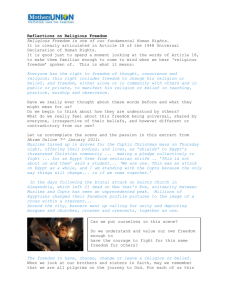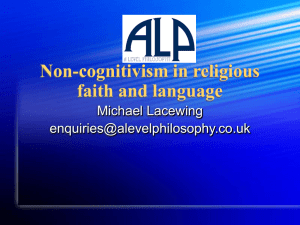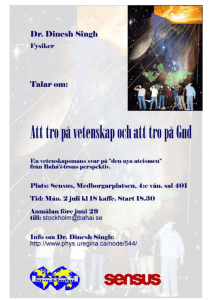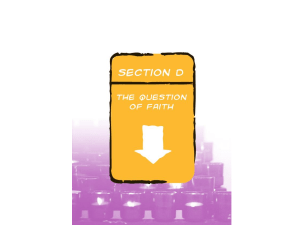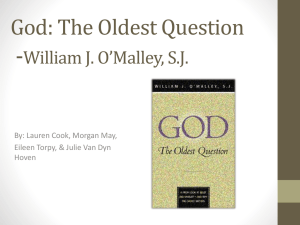LIFE OF PI - elwoodenglish12
advertisement
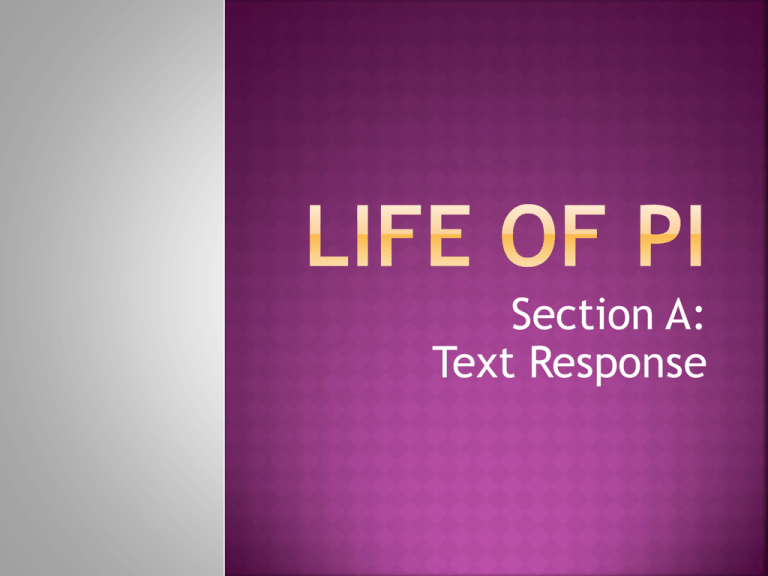
Section A: Text Response Respond to this section second, after Section C Read and digest the topics VERY carefully, be aware of the FOCUS of the questions and what TYPE of questions they are Your response should NOT be under 2 pages. Aim for 3-4 pages Demonstrates a close and perceptive reading of the text, exploring complexities of its concepts and construction. Demonstrates an understanding of the implications of the topic, using an appropriate strategy for dealing with it, and exploring its complexity from the basis of the text. Develops a cogent, controlled and wellsubstantiated discussion using precise and expressive language. CHARACTER THEMES/IDEAS VALUES SETTING STRUCTURE QUOTE – you do not have to repeat the quote in your response, but you MUST acknowledge its meaning and context TO WHAT EXTENT DO YOU AGREE? – Do not be tempted to include yourself or become argumentative. Don’t sit on the fence but also allow yourself to discuss multiple interpretations HOW DOES THE AUTHOR – Asking you to reference the construction of the text, to use the novel’s conventions and author’s style as the basis of your discussion. DISCUSS – Present the most sophisticated ideas in a discursive fashion Be argumentative Be judgmental Be complimentary to the author Ignore parts of the topic Retell the plot Try and use everything you know How does Martel, in his text ‘Life of Pi’, suggest that a ‘better story’ is more important than the truth? FOCUS = Values (with themes of storytelling and reality) TYPE = ‘How does the author’ and Quote Richard Parker is essential to Pi’s survival. Discuss. FOCUS = Character (with ideas of survival) TYPE = Discuss “We believe what we see.” To what extent is sensory belief questioned in ‘Life of Pi’? FOCUS – Themes/Ideas (belief, religion, storytelling, science) TYPE – ‘To what extent’ and Quote Identify FOCUS and TYPE of topic Identify key terms in topic Brainstorm the MOST sophisticated ideas, not necessarily the most rehearsed or easiest Determine paragraph ideas Link Quotes, Values and Structural Features to your ideas Pi survives because of his faith; his faith gives him the ability to have hope. However, Pi’s ability to have faith in multiple religions (something quite out of the ordinary) is questioned at the beginning by those who hold faith in only one religion. It is possible that Pi survives his time at sea because of his ability to have faith in all possibilities (where others don’t). Pi, and in essence, Martel, points out (via discussions about agnostics) that it is important to believe in something; to have faith in one’s convictions. The reader is not forced to believe Pi’s tale of survival – but by the end are asked to question their own ideas on what is possible While the text is designed to ‘make you believe in God’, it is also implied that God is everywhere and especially in miraculous events and undiscovered territory. The text is carefully crafted to stimulate the reader’s belief in the characters and the events that take place. Okamoto and Chiba are the reader’s ‘reality check’ – however they are painted as foolish, bumbling and unspiritual. Here though, the reader is not judged for believing Pi’s tale or not – but they are asked to acknowledge the possibility of things beyond their realm of belief. Pi’s prayers help create routine – and as a scientist he believes in the logic of order While it is possible that RP represents fear, it is also possible that he represents a God Pi’s love of storytelling stems from his passion for religion. If Pi’s alternate story, where he is RP, is the true version of events, then his ability to create such a protective and wild fantasy is a result of his religious beliefs. Pi believes in ‘the harmony of order’. He is a scientist and was brought up to believe in behavioural science, both of animals and humans His name is symbolic of the irregular relationship he has with religion and science, as well as the endless possibilities for both He survives by routine, lists, manuals and plans Pi details how religion and zoos are no longer in people’s ‘good graces’ – both are misunderstood as places of captivity He also believes, scientifically, that man is the ‘most dangerous’ animal; that while animals can be instinctively dangerous, man can be purposely cruel. Although Pi knows the rules of anthropomorphism, he is still disappointed when RP leaves him so ‘unceremoniously’. Both disciplines that Pi end up studying in Toronto, Zoology and Religion, are concerned with mystery and wonder. RP’s interaction with Pi is one of biological necessity Their co-dependence brings Pi a sense of ‘wholeness’ RP’s name gives the illusion of humanity (and elements of humour to the construction of the text) Pi mourns RP as not only one who ‘saved’ him, but also as the last link to his former life and family If the alternative story is the true version, then RP is Pi’s created alter-ego. RP, represents all the ugly parts of Pi’s survival. He commits murder, cannibalism, and breaks religious convictions, on Pi’s behalf. He makes himself into a Bengal Tiger, the most ferocious animal in the zoo. Once he hits dry land, he no longer needs to hide behind RP – and this side of Pi is never seen again. The three sections and exactly 100 chapters reflect Pi’s belief in order The ‘author’s note’ as a deceptive tool – uses thank yous and confessions as credibility Humour as a celebration of life and all it’s avenues, possibilities and characters Pi’s time in Pondicherry spoon-feeds the reader ‘facts’ to make his survival more believable. Eg, focus on swimming, lessons about alpha-male behaviour and territory Pi’s voice has a matter-of-fact quality that contrasts sharply with the tale he is relating Good stories stretch a reader’s ability to suspend disbelief Stories are adapted to suit their context; you can take from them whatever meaning you wish Language, particularly words, are important in the storytelling process. They can be chosen for their meaning (‘Pi’), their nuance (‘Richard Parker’) or their sonic effect (‘figment’, ‘fig’). It is important to believe in something Belief and Reason are more closely related than most believe Science and Religion have more in common than people think – it is the dialogue, the words, the semantics, that surround them that make them seem so different. No one can survive alone Faith is ‘an opening up, a letting go, a deep trust, a free act of love’ Life is important to fight for One would be foolish to only believe in what they can see The small things, the smells in a house, or the colours of the ocean, are beautiful, miraculous and shouldn’t be missed Humans are the most dangerous creature yet discovered Sometimes the ‘better story’ is more important than the truth Pi and the author’s ‘hunger’ is for meaning; stressing the importance of looking for more to believe in, having a thirst for life (as opposed to ‘dry, yeastless factuality’) Anything is possible
